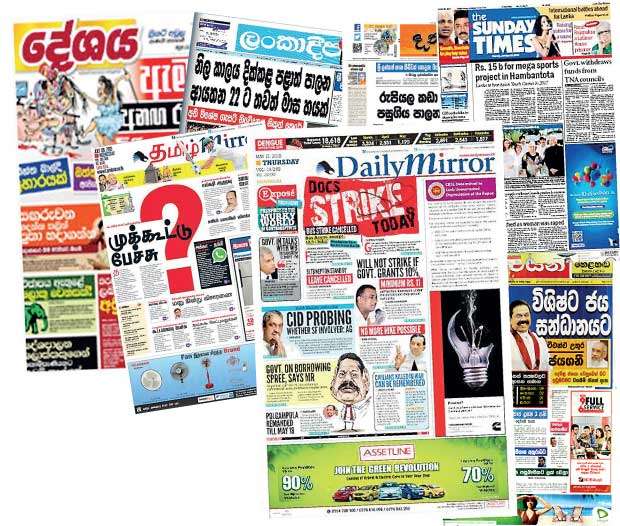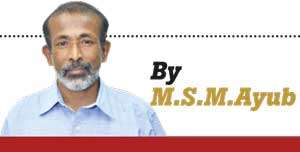Reply To:
Name - Reply Comment
Last Updated : 2024-05-19 17:25:00

If a foreigner who can read both Sinhala and Tamil goes through the newspapers published in Sri Lanka in those two languages he might conclude that he was reading newspapers published in two countries. There is such a vast and strange gap between the priorities of Sinhala and Tamil newspapers.
newspapers.
Currently it is the conflict between the two main parties in the Government and the attempts or pretense by certain circles to bring in a patch up between President Maithripala Sirisena and former President Mahinda Rajapaksa are the main topics for the Sinhala and English newspapers, while Tamil papers are focussing on PTA detainees, lands occupied by the Security Forces and people who went missing during the war. Since lately the estate workers’ demand for a higher salary has been added to them.
The issues highlighted in the Tamil media are currently making a huge impact on the Tamil political landscape, with more and more cracks appearing in the main Tamil coalition, the Tamil National Alliance (TNA).
Two leading figures in the North, the former Chief Minister of the Northern Provincial Council C.V.Wigneswaran and a former member of the same council Ananthi Sasitharan had announced within a week that they would form new political parties rival to the TNA. It is not clear whether the background and the impact of the split in the TNA on the national politics are clear to the south.
In a move to underscore the media’s impact on the psyche and the intelligence of the masses once, some time ago, a questionnaire containing some queries on the ethnic issue were circulated among the participants of a workshop for journalists.
Obviously, the answers received from the Sinhalese and Tamil speaking journalists for a question whether Tamils in Sri Lanka have special problems that would push them to live in a separate country were diametrically varied.
"The impact of the Sinhala Only Act on the lives of the ordinary Tamil speaking man was not known by the majority of Sinhalese even after the thirty-year-long war, as it has never been a subject in the Sinhala media"
Also, another question whether the participants prefer Federalism as the answer to the present ethnic conflict drew totally different answers from the Sinhalese and Tamil speaking journalists.
But, interestingly, when it came to the definition of Federalism, both groups created a scenario that reminded us of the proverbial blind men who described the elephant by touching various parts of its body.
Each person had his or her own definition, according to his or her liking, but not on a scientific basis.
In short, nobody knew what Federalism really meant, but a group of people speaking a particular language preferred it, while the other group who spoke another language hated it.
It was clear that each group had been psyched up by the media in their respective languages.
This is not a new phenomenon. And this is a phenomenon that could be witnessed always when it comes to ethnic issues. In a way, one could also argue that this media behaviour had largely contributed to the aggravation of the ethnic conflict into a three-decade long war, apart from the opportunistic policies of politicians on either side of the ethnic divide.
When the Official Language Act or the Sinhala only Act, as it was commonly known was introduced in 1956 by the late Prime Minister S.W.R.D. Bandaranaike it was seen by the majority of Sinhalese as a great achievement despite it being viewed by the Tamils as a great injustice to them.
In fact, the impact of the Act on the lives of the ordinary Tamil speaking man was not known by the majority of Sinhalese even after the thirty-year-long war, as it has never been a subject in the Sinhala media.
Vast and strange gap between the priorities of Sinhala and Tamil newspapers
Each group had been psyched up by the media in their respective language
The agitations against the Act were seen by the Sinhala media and thereby the southern people merely as a prestige issue.
Standardization of qualifications for University entrance was another major issue that was used by the Tamil politicians and the Tamil armed groups to justify their struggles and the armed uprising.
Despite the introduction of the standardization having affected a section of the Sinhalese students in the urban areas as well, the media hype created by the Tamil politicians against it ultimately depicted it as another injustice only to the Tamil speaking students.
They did not want to agitate against the law collectively with Sinhalese students, who had also been affected and the Tamil media never viewed it as an issue common to all students in urban areas.
During the war between the State Armed forces and the Liberation Tigers of Tamil Eelam (LTTE) polarization of the media outlook and its priorities came to a head.
Sinhala media always attempted to justify every act of the Armed forces while the Tamil media were doing the opposite.
The main reason for this situation was that both the media had different sources that could satisfy their respective audiences. Due to the restrictions on the accessibility to the war theatre Sinhala media had to rely totally on the Army Spokesman while Tamil journalists had reposed their trust on S.P.Thamilchelvan, the Media Spokesman of the LTTE or Rasiah Illanthiraian, the Military Spokesman of the organization.
A large number of civilians were killed at the hands of both the combatants on either side during the war. But the figures, circumstances and the culprits were not always the same in Tamil and Sinhala language media.
For instance, during the early years of the war, in April 1984 a massive clearing operation was launched in Jaffna and the Reuters reported that more than 300 people had been killed. The censorship in operation during that time helped the Sinhala and English media to downplay the situation, but the Tamil media managed to tell their audience as to what had happened by publishing the names and ages of those “terrorists” killed during the operation.
The polarization of the media outlook and its priorities came to a head with the war
The trend of defending our boys or our people or covering up of their crimes while demonizing the others still continues
Similarly, the Tamil media totally forgot the attack on the Buddhist devotees at the Sri Maha Bodhi in Anuradhapura on May 14, 1985, and the Pettah bomb blast carried out by the LTTE on April 21, 1987, after the initial reportage.
In each of those incidents, more than 300 people had been killed.
In spite of the Muslims in Sri Lanka mainly being Tamil speaking people, rarely a commemorative piece on the driving away of nearly a hundred thousand Muslims from the North in October 1990 is published in Tamil media.
While Sinhala media commemorate those incidents annually with articles and interviews of survivors, Tamil media have some other similar incidents to commemorate.
This trend of defending or sympathizing with “our boys” or “our people” or covering up of their crimes while demonizing “others” still continues up to date.
For the past nine years after the end of the war, people in the North have been agitating over three major issues, namely the private lands still occupied by the Armed forces, people who went missing during and after the war and people detained under the Prevention of Terrorism Act (PTA).
There had been months-long and yearlong continual protests against what the Tamils call the apathy on the part of the Government towards these issues, but interestingly without drawing the interest of
the South.
Sach Friday, 26 October 2018 01:14 PM
A good article. Not only about war even day-to-day issues in north is not published in English or Sinhala media leaving the readers in ignorance. However Sinhala language alternative newspapers like Ravaya fill that gap to a certain extent. But you won't see a Tamil version of Ravaya.

Add comment
Comments will be edited (grammar, spelling and slang) and authorized at the discretion of Daily Mirror online. The website also has the right not to publish selected comments.
Reply To:
Name - Reply Comment
The state-run loss-making State Mortgage & Investment Bank (SMIB) has reveale
US authorities are currently reviewing the manifest of every cargo aboard MV
On March 26, a couple arriving from Thailand was arrested with 88 live animal
According to villagers from Naula-Moragolla out of 105 families 80 can afford